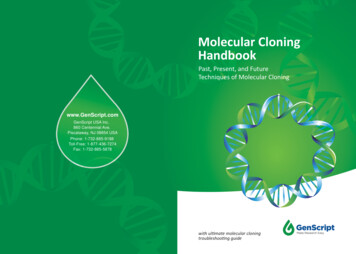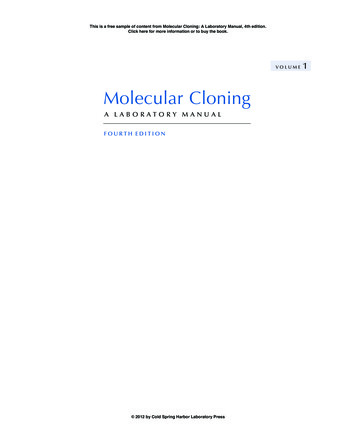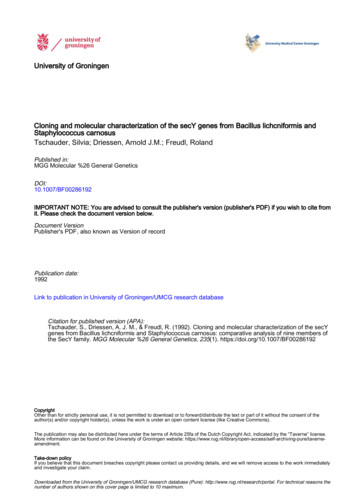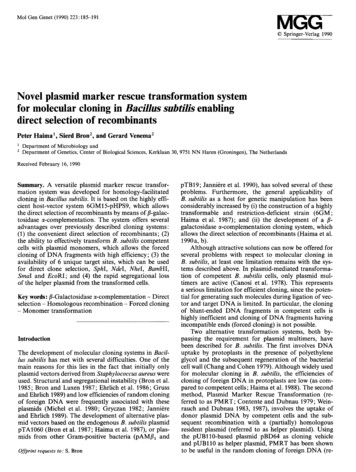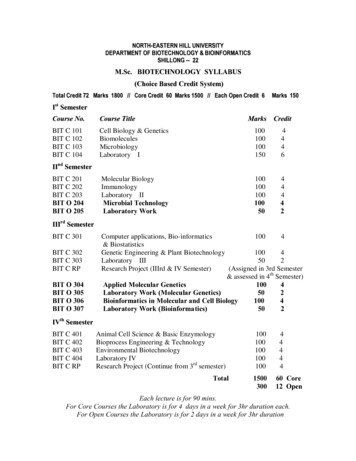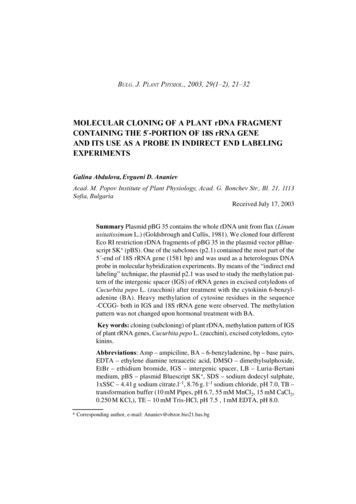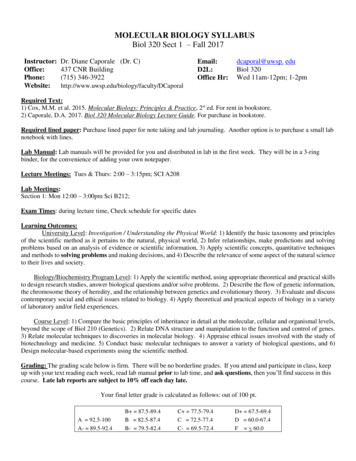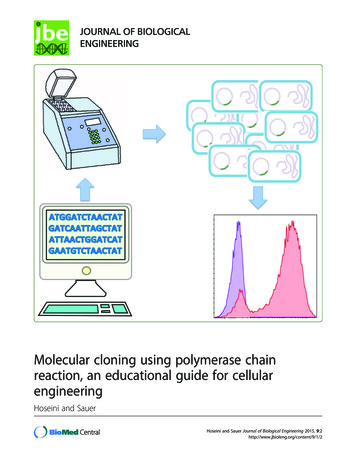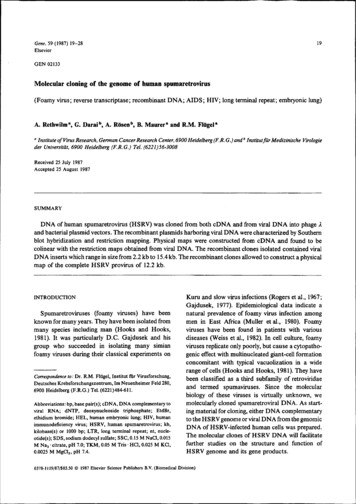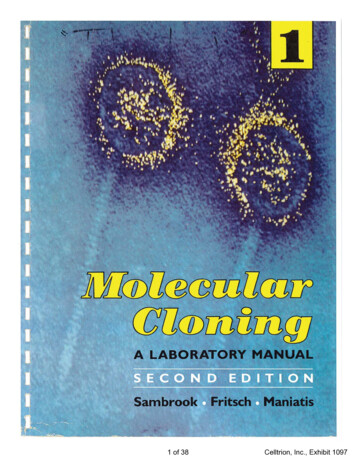
Transcription
COREMetadata, citation and similar papers at core.ac.ukProvided by Online-Publikations-Server der Universität WürzburgGENOMICS 3, 117-123 (1988)Molecular Mapping and Cloning of the Breakpointsof a Chromosome 11 p 14. 1-p 13 Deletion Associatedwith the AGR SyndromeMANFRED GESSLER AND GAtlA. P.BRUNSGenetics Division, The Children's Hospital, and Department of Pediatrics, Harvard Medical Schoo/, Boston, Massachusetts 02115Received March 10, 1988; revised June 23, 1988Recent cytogenetic studies (Douglass et al., 1985)suggest that rearrangements at chromosome 11p13 occur frequently in Wilms tumors from patients withnormal phenotypes. Individual& having only the developmental defects of the AGR triad also exhibitchromosome 11p abnormalities in the absence oftumorformation. In two kindrede of familial aniridia (Simolaet al., 1983; Moore et al., 1986) the disorder segregatedwith translocation chromosomes with chromosome 11breakpointe at band p13 in both caees. These findingsindicate that band p13 of chromosome 11likely contains not only a tumor suppressor gene but also genesinvolved in differentiation and development of severalorgan systems. Furthermore, the frequent chromosomeaberrations described for this region raise the questionwhether these rearrangements involve a commonmechanism or specific sites which facilitate recombination.In the present report we describe the molecularmapping of a 11p14.1-p13 deletion found in a patientwith aniridia, genitourinary anomalies, and mental retardation. The breakpointe have been cloned and definenew markers for a more detailed map of this region.Chromosome 11p13 is frequently rearranged in individuals with the WAGR syn.drome (WUms tumor,aniridia, genitourinary anomalies, and mental retardation) or part& of this syndrome. To map the cytogenetic aberrations molecularly, we screened DNAfrom cell Unes with known WAGR-related chromosome abnormalities for rearrangements with pulsedfleld gel (PFG) analysis using probes deleted from onechromosome 11 homolog ol a WAGR patient. The ftrstalterationwas detected in a cell Une lrom an individualwith aniridia, genitourinary anomalies, mental retardation, and a deletlon described as 11p14.1-p13. Wehave located one breakpoint close to probe HU11184B and we have cloned both breakpoint sites as wenas the junctional fragment. The breakpoint& subdividecurrent intervals on the genetic map, and the probeslor both sides will serve as important additionalmarkers for a long-range restriction map of this region. Further characterization and sequencing of thebreakpoints may yleld insight into the mechanisms bywhich these deletions occur. e lt&&AcactemJcPrea,Iac.Rearrangements of chromosome 11 are implicatedin a variety of clinical disorders. Among the first cytogenetic abnormalities found were frequent deletionson the short arm involving band p13 in patients withWAGR syndrome, which consists ofWilms tumor, aniridia, genitourinary malformations, and mental retardation (Francke et aL, 1979; Riccardi et al., 1980). Forthe formation of Wilms tumor, the most common solidtumor in childhood, a two-step model of tumorigenesiswas postulated (Knudson and Strong, 1972) with thefirst step already inherited in the familial form of thetumor. Studies on polymorphisms in tumors and normal tissue (Fearon et al., 1984; Koufos et al., 1984; Orkin et al., 1984; Reeve et al., 1984) indicated that thesetwo steps might result in the functional inactivationof a recessive gene through deletion or reduction tohomozygosity for a mutant allele.MATERIALS AND METHODSCell LinesGM 7736 cells were obtained from the NIGMS Human Genetic Mutant Cell Repository (Camden, NJ).The 6697 lymphoblastoid cells were derived from akaryotypically normal male. E36 hamster cells and hybrid celllines G35F3, G95A4, RJK34, G156F3, G157A6,and G157A2 have been previously described (Scott etal., 1979; Bruns et al., 1984; Glaser et al., 1986).DNA Extraction and Southem Blot AnalysisGenomic DNA was purified by SDS/proteinase Ktreatment and repeated extractions with phenol andchloreform followed by isopropanol precipitation1170888· 7M3/88 3.00Copyright 1988 by Academic Press, Inc.All righta of reproduction in any form reserved.
118GESSLER AND BRUNS(Maniatis et al., 1982). DNA concentrations were measured spectroßuorometrically (Brunk et aL, 1979) andrestriction enzyme digests were performed accordingto the manufacturer's instructions with 4-10 units/pgDNA for at least 3 h. Sampies were separated in 0.7%agarose gels and transferred to Gene Screen membranes (NEN, Boston, MA) with 0.5 N NaOH, 1.5 MNaCI overnight. Filters were then neutralized in 50mM NaP04 , pH 7.2, and baked for 2 h at 80 C, andnucleic acids were crosslinked to the membrane by uvirradiation (Church and Gilbert, 1984).Hybridization ConclitionsPurified DNA fragments were labelad according toFeinberg and Vogelstein (1984). Probes containing repeated sequences were competed with human DNAprior to hybridization as follows (Sealey et al., 1985).Labeled DNA was boiled with 1 mg heared placentalDNA in 5X SSC in a total volume of 100 pl and allowedto reanneal for 10-15 min at 68 C before being mixedwith hybridization buffer. After prehybridizing for 1 hin 0.5 M NaP04 , pH 7.2, 7% SDS, 1 mM EDTA at65 C (Church and Gilbert, 1984), filtere were bybridized overnight in fresh buffer with 50 pg/ml salmonsperm DNA and 2-10 X 107 cpm radioactive probe.Filters were washed in 40 mMNaP04 , pH 7.2, 1% SDSat 65 C. Filters could be reused after stripping of theprobe by incubating in 0.1X TE, 0.1% SOS at 75-80 Cfor 30 min.Gene Dosage StudiesEqual amounts of EcoRI-digested DNA from GM7736 and control celllines were separated electrophoretically and transferred to Gene Screen membranes.After hybridization and exposure to X-ray film, theautoradiograms were evaluated independently by twoinvestigators. Relative band intensities were measuredwith an LKB Iaser scanning densitometer.PFG AnalysisEmbedding of DNA and subsequent manipulationswere performed according to protocols provided by D.Barlow and H. Lehrach (EMBL, Heidelberg, FRG). Inbrief, cells were mixed with 1% LMP-agarose (BRL)in PBS giving a final concentration of 1-2 X 107/ml.and poured into 100-pl block formers. After incubatingin ESP (0.5 M EDTA, pH 8, 1% Na-laurylsarcosine,and 1 mg/ml proteinase K) for 2 days at 50 C, theblocke were washed extensively in TE at room temperature, twice at 5.0 C including 0.04 mg/ml PMSF(BRL), and were finally stored in 0.5 M EDTA, pH 8at 4 C.For restriction enzyme digests the blocke were cutinto halves and equilibrated in the appropriate buffer.Digests were performed in 120 pl total volume with 20units of enzyme for at least 6 h. Electrophoresis wascarried out in an LKB pulsaphor apparatus using thedouble inhomogeneous field electrodes (Schwartz andCantor, 1984; Carle and Olsen, 1984) or the CHEFelectrode array described by Chu et al. (1986). DNAtransfer and hybridizations were done as previouslydescribed with an extended blotting time of 48 h toallow transfer of the large DNA molecules.Phage X multimers and Saccharomyces cerevisiaechromosomes were used as size standards. Phage multimers were prepared by embedding PEG-precipitatedCharon 21A in LMP-agarose, digesting in ESP, andannealing of the cos ends in 0.1 M EDTA, pH 8 at50 C for 2 days. Chromosomes from S. cerevisiae wereprepared as described by Carle and Olson (1985).Genomic CloningA Mbol partial digest library of normal human lymphoblast DNA in EMBL 3 phage was generously provided by Dr. S. Orkin. For the GM 7736 completeBamHI digest library, 10 pg ofDNA was digested with100 units of BamHI for 3 h followed by phenol andether extraction and dialysis against TE. One microgram of digested DNA was Iigated with 2 p.g of BamHIcut EMBL 3 DNA (Stratagene, La Jolla, CA) at 4 Covemight and packaged in vitro with Gigapack gold(Stratagene). Afterplatingon Escherichia coli strainP2392, 400,000 clones were obtained.Screening of phage libraries and subcloning ofDNA fragments into plasmid vectors pUC19 andpBLUESCRIPT (Stratagene) were done according topublished procedures (Maniatis et al., 1982). PhageDNA minipreps were carried out essentially as described by Helms et al. (1985).RESULTSDetection of the RearrangementTo obtain probes from the region of chromosome 11that is frequently deleted in W AGR patients, wescreened phage inserts from the complete Hindill digest flow-sorted chromosome 11library of the NationalGene Library Project (LL11NS01) against a panel ofhuman-rodent somatic cell hybrid lines containingchromosome 11 homologe with different WAGR deletions (Bruns et al., in preparation). Single-copy pieceswere sought for clones that mapped to deleted areas,and we created long-range restriction maps by digestionof agarose-embedded pnomic DNA with rare-cuttingrestriction enzymes and separation of fragments withpulsed field gradient gel electrophoresia (Schwartz andCantor, 1984; Carle and Olsen, 1984). With these mapsas a reference we examined DNA from four celllineswith cytogenetically described chromosome 11 aber-
119MAPPING AND CLONING OF del llp14.1-p13rations for indications of rearrangements within themapped regions araund 12 probes.The first alteration found was that in DNA from thecellline GM 7736 which was derived from an individualwith bilateral aniridia, genitourinary anomalies, mentalretardation, and a deletion described as 11p14.1-p13.Probe HUll-25, which hybridizes to a Sfil fragmentof 660 kb in DNA from normal cells, detected an additional band of about 600 kb for the cellline GM 7736upon PFG analysis (Fig. 1). Subsequent digests withadditional rare-cutting enzymes revealed more abnormal fragments which hybridized with intensities comparable to those of the unrearranged fragments in thesame DNA. A Sacll band of900 kb was shortened by150 kb, and a 1.2-Mb Notl fragment appeared underconditions where the normal fragment would not haveentered the gel (not shown). These multiple aberrationsseen with probe HUll-25 only in GM 7736 and not inany other cell line tested made it very likely that thisprobe detected the rearranged fragments of thellp14.1-p13 deletion. The restriction map aroundHUll-25 from anormal cellline (Fig. 1) puts this presumed breakpoint between the Sfil and BssHII sites,as digestion with BssHII did not produce an additionalfragment in GM 7736.A second random probe, HU11-164B, could be linkedto HUll-25 by ahared Sacll and Sfii fragments of900and 660 kb (data not shown) and is localized in theSfii/BssHII interval to which the GM 7736 breakpointwas assigned. Gene dosage studies showed that bothalleles forthisprobe were present in GM 7736. As expected, all the altered bands previously detected byHUll-25 were again seen with HU11-164B. This probealso identified a rearranged BssHII fragment, confirming its position closer to the putative breakpoint.Cloning of the BreakpointSeveral restriction enzymes (Apal, Bam.HI, Bell,Bglll, EcoRI, Hindiii, Xhol) that cut more frequentlyin human DNA were then used to estimate the distancefrom HU11-164B to the site of the GM 7736 rearrangement. Kpnl was the enzyme that produced theshortest fragments among those detecting altered restriction patterns. The sizes were calculated as 11 kbfor the normal and 13 kb for the altered band. ProbeHU11-164B was used to screen a genomic Mbol partialdigest library in EMBL 3 phage, and two of the overlapping clones, 164-5 and 164-8, spanning 25 kb wereanalyzed further. One ofthe subclones, 0.6ES, detectedrearranged fragments in GM 7736 DNA with every enzyme tested upon conventional Southern blot analysis(Fig. 2C). Only the regular bands light up on the sameblot (Fig. 2B) with probe 0.2SB, which is immediatelyNDNO ND NDNONDNDND.\NDNDNotVSalllSallStil Sac IIBssH.IISacllIIClH11-1648I IDH11-25NDNDSacll . BssH IIBssHIISfi I Sac IIBssH.IIIt---i100kbFIG. 1. Detection ofthe GM 7736 rearrangement with probe HUll-25. Agaroseblocks with GM 7736 (D) and 6697 control (N) DNAswere digested with the enzymes indicated and separated in a 1% agarose gel using the CHEF electrode array (Chu et aL, 1986) at 170 V with80 s switching time and 11 C buffer temperature. Left: The ethidium bromide staining with Charon 21A multimers as size markers. Right:The hybridization pattem with probe HUll-25. The restriction map around probes HUll-25 and HU11-164B is indicated with the presumedbreakpoint between HUU-1648 and the flanking Sfil site.
GESSLER AND BRUNS120ONDNDNDNHlnd 111 Kpn IONHind III Kpn I EcoR I BamH IEcoR I BamH IHlnd 111 Kpn I EcoR I BamH IPROBE 0.2SBPROBE 2.3X'DNONDNONONONONEPROBE 0.6ESEE---- --- ---11-----t-:;,. ------ NORMAL ',PH PH,,.-,. .- ,. . . ----' 0.298 0.6ESqHtt-1848'----·E--'-xiilliill. . ---- GM77361 - - - - - - - - i "7789.tkbFIG. 2. Analysis of the GM 7736 breakpoints. Four micrograms of GM 7736 (D) and 6697 control (N) DNA digested with the enzymesindicated below was separated electrophoretically and transferred to Gene Screen membrane. The same filter was uaed for bybridization withprobes 2.3X (A), 0.2SB (B), and 0.6ES (C). Arrows indicate the rearranged fragments detected by probes 2.3X and 0.6ES. Size markers inthe left lanes are radioactively labeled X-Hindlll fragments. Tbe restriction map ofthe normal and deleted allele of GM 7736 is sbown. EcoRI(E) restriction site as wellas the hybridization probes used and the location ofthe cloned fragment from the deleted chromoaome are indicated.adjacent to 0.6ES in normal DNA. Furthermore, genedosage analysis showed that probe 0.2SB is presentonly on one allele in this cellline. This confirms thatprobe 0.6ES contains the site ofthe deletion breakpointin GM 7736, whereas probe 0.2ES is deleted from onechromosome 11 homolog.To obtain the deletion junction, contained withinthe rearranged BamHI fragment of 9.5 kb (Fig. 2C),we prepared a complete BamHI digest library of GM7736 DNA in EMBL 3 phage without prior phosphatasetreatment of the insert to ensure clonability of thisfragment. The library was screened with probe 0.6ES,and the BamHI insert of one of the resulting nineclones, 77B-9, showed restriction patterns compatiblewith the rearranged allele. A 2.3-kb Xbal fragment(2.3X) which was absent from clones 164-5 and 1648 suggested that 77B-9 contained the junction fragment. All the altered bands detected witb probe 0.6ESupon Southem blot analysis of GM 7736 DNA werealso seen with probe 2.3X (Fig. 2A}. The bands for thenormal allele, also present in control DNA, were of adifferent size in all cases. Finally, mapping with somaticcell hybrids confirmed its localization to chromosome11 (data not shown).Clones for the normal allele from the other deletionboundary were obtained by screening the BamHI library with probe 2.3X. Two identical phage clones( 77N1 2) could be retrieved Tbe deletion breakpointcould be narrowed down to a 1.2-kb Pvuii/Hindlllfragment. An adjacent Pvuii/Hindlll piece of 1.4 kbwas missing from the junction clone and detected onlyDNA fragments corresponding to the normal alleleupon Southem blot analysis of GM 7736. The intensityof the hybridization signal was reduced compared tothat of control DNA. Hybridization against a humanrodent hybrid panel confirmed the assignment to chromosome 11p (Fig. 3). The 1.4-kb Pvuii/Hindlll fragment also detected a Hindill polymorphism in 6697DNA wbich segregated in the hybrid panel. Among 28chromosomes, the allele frequencies were p 0.61 andq 0.39. Mendelian inheritance of the RFLP was observed.Chromosomal MappingTheorientation of the cloned DNA relative to thecentromere was established by mapping the probesagainst two previously characterized human-hamstersomatic cell hybrid lines containing chromosome 11alleles with deletions of different size from WAGR patients (Bruns et al., 1984). The catalase gene had beenshown to be absent in the !arger deletion (G156F3,N.W.) but tobe present on the other WAGR deletionchromosome with a smaller deletion (G157A6, M.J.)where tbe gene was mapped proximal to the breakpoint(Glaser et al." 1986). Gene dosage studies on GM 7736indicated that tbe catalase gene lies within tbe deletedregion and is present only on the normal allele (Fig.4). Probes HU11-25 and HU11-164B, whicb are missing from botb hybrid lines, therefore represent the distal end of the deletion. Tbe proximal boundary falls inthe interval between the catalase gene and the lower
121MAPPING AND CLONING OF del llp14.1-p13234567was probed with the catalase cDNA clone (data notshown). This suggests that the proximal breakpoint inGM 7736 is located less than 1.2 Mb away from thecatalase gene on the centromeric side of the gene. Hybridization patterns of Nrul and Mlul digests whichproduce !arger fragments have confirmed this linkage.The size of the deleted region can be estilnated onlyfrom the restriction maps around clones that are located within this area such as the FSHB gene and several of our random probes isolated from the ftow-sortedchromosome 11library (Gessler et aL, in preparation).At least 4 million base pairs seem to be missing fromthe deleted chromosome. More exact measurements,however, can be made only after complete link-up ofthe intemal clones with PFG analysis.8kb13-2.3-FIG. S. Chromosome mapping of the proximal breakpoint site.Probe 1.4PH was hybridized to a mapping panel of Hinc:UII-digestedDNAs from (1) human 6697 cells; (2) Chinese hamater E36 cella;(Sand 8) human-hamater hybrid& with chromosome 11; (4) humanhamaterhybrid with the X aa the solehuman chromosome; (ö) human-mouse hybrid with an llpter-q23::Xq26-qter translocationchromosome; (6) the N.W. deletion hybrid G156F3; (7) the M.J.deletionhybrid Gl67A6. Chromosome 11 and Xq26-qter were theonly human chromosomal elements ahared by the hybride in laneaS, 5, 7, and 8. The absence of hybridization to the DNA in lane 4indicates that probe 1.4PH can be 888igned to chromosome 11. AHindiii polymorphism is observed with this probe.DISCUSSIONChromosomal rearrangements are associated with agrowing number of malignancies and developmentaldefects. Among the most extensively studied abnormalbreaks are the chromosome translocations s en inBurkitt Iymphoma (Dalla-Favera et al., 1982; Taub etal., 1982) and chronic myeloid leukemia (de Klein etal., 1982; Groffen et al., 1984) where a cellular protooncogene is joined with one of the immunoglobulingenes or in the latter case with the her gene. Thesetranslocations were found in almost every case, butwere restricted to tumor cells as part of the malignantprocess.The deletion described in the present report, however, belongs to another group of cancer-associatedrearrangements in which the malignant phenotype appears to be a recessive trait. This group includes theWAGR syndrome, retinoblastoma, small celllung carcinoma, and neuroblastoma (Francke et al., 1979; Riccardi et al., 1980; Balaban et al., 1982; Benedict et al.,1983; Whang-Peng et al., 1982; Brodeur et al., 1981).The chromosomal deletions are generated mostly as asomatic mutation in the a.ffected individual, but in someinstances they can also be inherited through the germline. The characteristics of the breakpoints have notbeen analyzed to date in any of the cytogenetically described rearrangements. Only the recent isolation ofbreakpoint ofthe !arger N.W. WAGR deletion isolatedin G156F3 (Figs. 3 and 4). Additional gene dosagestudies with the cell line GM 3118 (J.K.) confirmedthese results (not shown).Molecu/ar MappingPFG analysis for the new probes with the enzymesSacll, Sfii, and BssHII .confirmed their localization.Probe 0.6ES identified the same normal and alteredfragments as HU11-164B in GM 7736 DNA (Fig. 5C).With probe 0.2SB only the bands representing thenormal allele were seen on the same blot (Fig. 5B).Probe 2.3X detected not only the same rearrangedfragments as 0.6ES but also new and different sizedones derived from the normal allele (Fig. 5A). Hybridization of probes from the lower breakpoint to Notldigested DNA showed a band of about 1.2 Mb in size.A fragment of the same size was seen when the blotG1 ; G157A8 -- ---------- ,,GM7738 1?-.cen2.3XCATFSHBH11164BH1125HBVS1pter.FIG. 4. Genetic map of the deletiona. Probea CAT, FSHB, and HBVS1 have been previously mapped on hybrid& G156F3 and G157A6(Glaser et aL, 1986). The cloned deletion breakpoints of GM 7736 subdivide the intervals described and orient the breakpoints relative to thecentromere.
122GESSLER AND BRUNSkb-800-600-400Bs SfScBs SfScPROBE 2.3XBs Sf ScBs Sf ScPROBE 0.258BsSf ScBs Sf ScPROBE 0.6ESFIG. 5. PFG analyaia of the GM 7736 deletion. Agarose blocke with 6697 control and GM 7736 DNA were digested with the enzymeaBssHII (Ba), Sfil (Sf), and Sacll (Sc) and separated. in an LKB pulsaphor apparatus at 330 V with 80 s awitching time and 11 C buft'ertemperature. After tranafer, the filter was aequentially hybridized with probea 2.3X (A), 0.2SB (B), and 0.6ES (C). Arrowe indicate the bandscorreaponding to the rearranged allele.the retinoblastoma gene (Friend et al., 1986; Fung etal., 1987; Lee et al., 1987) has led to the detection of anum.ber ofbreakpoints in constitutive and tumor DNAswhich can now be cloned and studied in detail.The present mapping and cloning of the breakpointsof a deletion llp14.1-p13 from an individual with aniridia, genitourinary anomalies, and mental retardationrepresent the first characterization of a WAGR-relateddeletion. The individual, now 5 years old, has not developed Wilms tumor. It is nevertheless likely that oneallele of the Wilms tumor gene was included in thedeletion, as the Banking markers CAT and FSHB(Glaser et aL, 1986) were both missing from tbe deletedchromosome. With the normal alleles for both breakpoints now available, it may be possible to obtain moreinsight into the mechanisms for these rearrangementsby sequence analysis and comparison with similarbreakpoints from other cancer-related deletions andtranslocations.The molecular characterization of the GM 7736deletion also helps to establish a physical map of theWAGR region by providing additional breakpoints tosubdivide present intervals ofthe genetic map (Glaseret al., 1986), which allows more precise mapping of anynew probe. The breakpoint clones described will provide valuable additional Iandmarks for a complete linkup long-range restriction map of chromosomellp14-p13.excellent technical asaistance. This work was supported by NIHGrant GM 34988. M.G. is recipient of a postdoctoral feUowship fromthe Deutsche Forachunpgemeinachaft through the Univeraity ofGieasen, FRG.REFERENCES1.2.3.4.5.6.7.8.ACKNOWLEDGMENTS9.We thank B. S. Emanuel for details of the clinical eyndrome inthis child with the deletion and J. Brennick and S. D. Bames for10.BALA.BAN, G., GILBERT, F., NICHOLS, W., MEADOWS, A. T.,AND SHIELDS, J. (1982). Abnormalitiea of chromosome #13 inretinoblaatomaa from individuals with normal conatitutionalkaryotypes. Cancer Genet. Cytogenet. 8: 213-221.BENEDICT, W. F., BANERJEE, A., MARK, C., AND MURPHREE,A. L. (1983). Nonrandom chromosomal chaÜges in untreatedretinoblaatoma. Cancer Genet. Cytogenet. 10:311-333.BRODEUR, G. M., GREEN, A. A., HAYES, F. A., WILLIAMS,K. J., WILLIAMS, D. L., AND TSIATIS, A. A. (1981). Cytogeneticfeatures of human neuroblastomas and celllines. Cancer Res.41: 4678-4686.BRUNK, C., JONES, K., AND JAMES, T. (1979). Aesay for nanogramm quantitiea of DNA in cellular homogenates. AnaLBiochem. 92: 497-500.BRUNS, G. A. P., GLASER, T., GUSELLA, J. F., HOUSMAN,D. E., AND ORKIN, S. H. (1984). Chromosome 11 probea identified with a catalaae oligonucleotide. Amer. J. Hurn. Genet. 88:258.CARLE, G. F., AND OLSON, M. V. (1984). Separation of chromosomal DNA from yeaat by orthogonal-field-altemation gelelectrophoreaia. Nucleic Acids Res. 12: 5947-6664.CARLE, C. F., AND OLSON, M. V. (1985). An electrophoretickaryotype for yeaat. Proc. NotL Acad. Sei. USA 82: 375 3760.CHU, G., VOLLRATH, D., AND DAVIS, R. W. (1986). Separationof large DNA molecules by contour·clamped homogeneouaelectric fields. Science 284: 1582-1586.CHURCH, G. M., AND GILBERT, W. (1984). Genomic sequencing.Proc. NotL Acad. Sei. USA 81: 1991-1995.DALLA-FAVERA, R., BREGNI, M., ERIKSON, J., PATTERSON, D.,
MAPPING AND CLONING OF del 11p14.1-p13GALLO, R., AND CROCE, C. M. (1982). Human c-myc onc-geneia located on the region of chromosome 8 that is translocatedin Burkitt Iymphoma cells. Proc. Natl. Acad. Sei. USA 79:7824-7827.11. DE KLEIN, A.,VAN KEssEL.23.A. G., GROSVELD, G., BARTRAM,C. R., HAGEMELJER, A., BOOTSMA, D., SPURR, N. K., HEISTER·KAMP, N., GROFFEN, J., AND STEPHENSON, J. R. (1982). A cel-12.13.14.15.16.17.18.19.20.21.22.lular oncogene ia translocated to the Philadelphia chromosomein chronic myeloid leukaemia. Nature (London) 300: 765-767.DOUGLASS, E. C., WILIMAS, J. A., GREEN, A. A., AND LOOK, A.T. (1985). Abnorm&ities of chromosomes 1 and 11 in Wilms'tumor. Cancer Genet. Cytogenet. 14: 331-338.FEARON, E. R., VOGELSTEIN, B., AND FEINBERG, A. P. (1984).Somatic deletion and duplication of genes on chromosome 11in Wilms' tumors. Nature (London) 309: 176-178.FEINBERG, A. P., AND VOGELSTEIN, B. (1984). A technique forradiolabeling of DNA restriction endonuclease fragments tohigh apecific activity: Addendum. Anal. Biochern. 137: 266.FRANCKE, U., HOLMES, L. B., ATKINS, L., AND RICCARDI,V. M. (1979). Aniridia-Wilma' tumor a88ociation: Evidence forspecific deletion of llp13. Cytogenet. Ce/J Genet. 24: 185-192.FRIEND, S. F., BERNARDS, R., RoGELI, S., WEINBERG, R. A.,RAPAPORT, J. M., ALBERT, D. M., AND DRYJA, T. P. (1986). Ahuman DNA segment with propertiea of the gene that predispoaes to retinoblaatoma and osteosarcoma. Nature (London)323: 643-646.FUNG, Y.-K. T., MURPHREE, A. L., T'ANG, A., QIAN, J., HINRICHS, S. H., AND BENEDICT, W. F. (1987). Structural evidencefor the authenticity ofthe human retinoblaatoma gene. Science238: 1657-1661.GLASER, T., LEWIS, W. H., BRUNS, G. A. P., WATKINS, P. C.,RoGLER, C. E., SHOWS, T. B., POWERS, V. E., WILLARD, H. F.,GOGUEN, J. M., SIMOLA, K. 0. J., AND HOUSMAN, D. E. (1986).The ß-aubunit of follicle-stimulating hormone ia deleted in patients with aniridia and Wilms' tumor, allowing a further definition of the WAGR locus. Nature (London) 821: 882.GROFFEN, J., STEPHENSON, J. R., HElsTERKAMP, N., OE KLEIN,A., BARTRAM, C. R., AND GROSVELD, G. (1984). Philadelphiachromosomal breakpoints areeluatered within a limited region,bcr, on chromoaome 22. Ce/J 38: 93-99.HELMS, C., GRAHAM, M. J., DUTCHIK, J. E., AND OLSON, M.V. (1985). A new metbod for purifying Iambda DNA from phagelysates. DNA 4: 39-49.KNUDSON, A. G., AND STRONG, L. C. (1972). Mutation andcancer: A model for Wilms' tumor ofthe k.idney. J. Natl. CancerInst. 48: 313-324.KOUFOS, A., HANSEN, M. F., LAMPKIN.- B. C., WORKMAN,L. C., COPELAND, N. G., JENKINS, N. A., AND CAVENEE,24.25.26.27.123W. K. (1984). Loas of alleles at loci on human chromoaome 11during genesis of Wilms' tumor. Nature (London) 809: 170172.LEE, W.-H., BOOKSTEIN, R., HONG, F., YOUNG, L.-J., SHEW,J.-Y., AND LEE, E. Y.-H. P. (1987). Human retinoblaatoma susceptibility gene: Cloning, identification, and eequence. Science286: 1394-1399.MANIATIS, T., FRITSCH, E. F., AND SAMBROOK, J. (1982). ''Molecular Cloning: A Labaratory Manual," Cold Spring HarborLaboratory, Cold Spring Harbor, NY.MOORE, J. W., HYMAN, S., ANToNARAKIS, S. E., MULES, E. H.,AND THOMAS, G. H. (1986). Familial isolated aniridia associatedwith a translocation involving chromosomes 11 and 22 [t(ll;22)(p13;q12.2)]. Hum. Genet. 72:297-302.ORKIN, S. H., GOLDMAN, D. S., AND SALLAN, S. E. (1984). Development of homozygosity for chromoaome llp markers inWilms' tumor. Nature (London) 309: 172-174.REEVE, A. E., HOUSIAUX, P. J., GARDNER, R. J. M., CHEWINGS,W. E., GRINDLEY, R. M., AND MlLLOW, L. J. (1984). LossofaHarvey ras allele in sporsdie Wilms' tumor. Nature (London)309: 174-176.28. RICCARDI, V. M., HITTNER, H. M., FRANCKE, U., YUNIS, J. J.,LEDBETTER, 0., AND BORGES, W. (1980). The aniridia-Wilms'tumor 8880Ciation: The critical role of chromosome band llp13.29.30.31.32.33.34.Cancer Genet. Cytogenet. 2: 131-137.SCHWARTZ, D. C., AND CANTOR, c; R. (1984). Separation ofyeaat chromosome-sized DNAa by pulsed field gradient gelelectrophoresia. CeU 87: 67-75.SCOTI', A. F., PHILLIPS, J. A., AND MIGBON, B. R. (1979). DNArestriction endonuclease analysia for localization of human betaand delta globin genes on chromoaome 11. Proc. Natl. Acad.Sei. USA 78: 4563-4565.SEALEY, P. G., WHITTAKER, P. A., AND S01.1I'HERN, E. M. (1985).Removal of repeated sequences from hybridiaation probes. Nucleic Acids Res. 13: 1905-1923.SIMOLA, K. 0. J., KNUUTILA, S., KAITILA, I., PAKOLA, A., ANDPOHJA, P. (1983). Familial aniridia and tranalocation t(4;11)(q22;p13) without Wilma' tumor. Hum. Genet. 83: 158.TAUB, R., KIRSCH, 1., MORTON, C., LENOIR, G., SWAN, D.,TRoNICK, 8., AARONSON, S., AND LEDER, P. (1982). Translocation of the c-myc gene into the immunoglobulin heavy chainlocus in human Burkitt Iymphoma and mouse plaamacytomacells. Proc. NatL Acacl. Sei. USA 79: 7837-7841.WHANG-PENG, J., BUNN, P. A., KAo-SHAN, C. S., LEE, E. C.,CARNEY, D. N., GAZDAR, A., AND MINNA, J. D. (1982). A nonrandom chromosomal abnormality, del 3p(l4-32), in humansmall celllung cancer (SCLC). Cancer Genet. Cytogenet. 8: 119134.
published procedures (Maniatis et al., 1982). Phage DNA minipreps were carried out essentially as de scribed by Helms et al. (1985). RESULTS Detection of the Rearrangement To obtain probes from the region of chromosome 11 that is frequently deleted in W AGR patients, we screened phage inserts from the complete Hindill di
